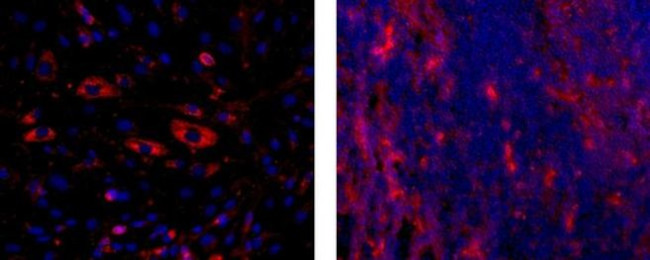Search Thermo Fisher Scientific
Invitrogen
CD141 Monoclonal Antibody (LS17-9), eBioscience™
Product Details
14-1411-82
Species Reactivity
Published species
Host/Isotype
Class
Type
Clone
Conjugate
Form
Concentration
Purification
Storage buffer
Contains
Storage conditions
Shipping conditions
RRID
Product Specific Information
Description: The monoclonal antibody LS17-9 recognizes mouse CD141 (Thrombomodulin, BDCA-3), a type I cell surface glycoprotein that binds to and allosterically activates thrombin. This complex cleaves protein C and the Thrombin Activatable Fibrinolysis Inhibitor (TAFI), initiating an important anticoagulant and antifibrinolytic pathway. Although expressed across many tissues and cell types, its highest expression has been reported on the lumenal surface of vascular endothelial cell. In the immune system the highest expression can be observed on monocytes and macrophages. Soluble CD141 is constitutively present in the serum at a very low level, and can be upregulated during inflammation. The anti-inflammatory activity of CD141 results from its ability to block the highly pro-inflammatory activity of thrombin. CD141 prevents chemotaxis and binding of granulocytes to activated endothelium, and inhibits activation of eosinophils and mast cells thereby reducing inflammation. Although human CD141 is commonly used as a marker of cross-presenting dendritic cells, mouse CD141 does not exhibit the same expression pattern.
Applications Reported: This LS17-9 antibody has been reported for use in immunohistochemical staining of frozen tissue sections, and immunocytochemistry.
Applications Tested: This LS17-9 antibody has been tested by immunohistochemistry of frozen mouse tissue and can be used at less than or equal to 10 µg/mL. This LS17-9 antibody has been tested by immunocytochemistry of methanol or formaldehyde-fixed and permeabilized mouse cells and can be used at less than or equal to 10 µg/mL. It is recommended that the antibody be carefully titrated for optimal performance in the assay of interest.
Purity: Greater than 90%, as determined by SDS-PAGE.
Aggregation: Less than 10%, as determined by HPLC.
Filtration: 0.2 µm post-manufacturing filtered.
Target Information
Thrombomodulin (TM) is also known as Fetomodulin (FM), endothelial anticoagulant protein, or glycoprotein P112. Thrombomodulin contains six repeated domains homologous with epidermal growth factor (EGF) and an amino terminal domain homologous to lectin-like protein. Through its accelerated activation of protein C, synthesis of TM is one of several mechanisms important in maintaining thrombo-resistance and thus reducing clot formation on the surface of the endothelial cells. Immunohistochemical staining of formalin-fixed tissue for TM has been used for the study of a variety of vascular tumors, meningiomas and choriocarcinomas.
For Research Use Only. Not for use in diagnostic procedures. Not for resale without express authorization.
Bioinformatics
Protein Aliases: BDCA-3; CD141; DC141; Fetomodulin; sCD141; snoRNA MBII-339; soluble CD141; Thrombomodulin; TM
Gene Aliases: AI385582; CD141; Thbd; TM
UniProt ID: (Mouse) P15306
Entrez Gene ID: (Mouse) 21824

Performance Guarantee
If an Invitrogen™ antibody doesn't perform as described on our website or datasheet,we'll replace the product at no cost to you, or provide you with a credit for a future purchase.*
Learn more
We're here to help
Get expert recommendations for common problems or connect directly with an on staff expert for technical assistance related to applications, equipment and general product use.
Contact tech support


